In the ever-evolving world of design and drafting, AutoCAD remains a cornerstone application for architects, engineers, and professionals across various disciplines. As we navigate through 2024, the demand for laptops that not only run AutoCAD efficiently but elevate the overall drafting experience is at an all-time high. Whether you’re a seasoned professional crafting intricate designs or a student learning the ropes of digital drafting, choosing the right laptop is pivotal.
This year, the market is brimming with options that cater to the diverse needs and workflows associated with AutoCAD. From powerhouse processors to graphics cards that render in exquisite detail, the right laptop can significantly enhance your productivity and creativity. However, with great variety comes the challenge of selection.
To assist in this crucial decision, we’ve meticulously analyzed and compiled a list of the best laptops for AutoCAD in 2024. Our selections hinge on a thorough evaluation of essential factors such as processing speed, graphics capabilities, memory, storage, display quality, and, importantly, the balance between performance and portability.
Before we delve into the detailed reviews that will guide you to your ideal AutoCAD companion, here’s a snapshot of our top picks for the year, designed to cater to a range of needs and preferences:
| Rank | Make/Model | Best For |
| 1. | Lenovo Legion Pro 7i Gen 8 | Best Overall |
| 2. | Asus ROG Strix G16 | Best Aesthetic |
| 3. | Razer Blade 16 | Best Dual-Mode Display |
| 4. | MSI Raider GE68HX | Best CPU Performance |
| 5. | Alienware X16 R1 | Best Premium Experience |
| 6. | Asus Zenbook 14 Pro | Best For Creatives |
Now, let’s explore what makes a laptop truly stand out for AutoCAD use and how you can align your needs with the specifications that matter most.
System Requirements for AutoCAD 2024: What You Need to Know
As we dive into the intricacies of AutoCAD 2024, it’s crucial to align your hardware with the software’s demands to ensure a seamless drafting experience. AutoCAD, with its Specialized Toolsets, is a robust application that requires a capable laptop to handle its comprehensive features. Here’s a breakdown of the system requirements for AutoCAD 2024 on Windows, guiding you through what to look for in your next laptop purchase:
Operating System: Compatibility starts with the operating system. AutoCAD 2024 demands a 64-bit version of Microsoft® Windows® 11 or Windows 10 version 1809 or above. This ensures that your laptop can run the latest features and updates smoothly.
Processor: The heart of your AutoCAD machine. For basic tasks, a processor with a base speed of 2.5–2.9 GHz is sufficient. However, for more intensive work, a processor with a base speed of 3+ GHz and a turbo boost of 4+ GHz is recommended. Note that ARM processors are not supported, emphasizing the need for a robust CPU architecture to handle complex designs.
Memory (RAM): Memory is key to multitasking and handling large files. With a minimum requirement of 8 GB for basic operations, we recommend ramping up to 32 GB of RAM to navigate through demanding projects with ease.
Display Resolution: A sharp, clear display is non-negotiable. For conventional displays, a resolution of 1920 x 1080 with True Color is the baseline. For professionals using high resolution & 4K displays, AutoCAD supports resolutions up to 3840 x 2160, provided you have a “Recommended” display card that meets the necessary specifications.
Display Card: AutoCAD leverages your laptop’s GPU for a myriad of critical operations. For basic use, a 2 GB GPU with 29 GB/s bandwidth and DirectX 11 compliance is required. For an enhanced drafting experience, especially in 3D modeling and high-resolution rendering, an 8 GB GPU with 106 GB/s bandwidth and DirectX 12 compliance is recommended. The importance of dedicated VRAM cannot be overstated, as it significantly impacts the software’s performance and your overall productivity.
Disk Space: With a suggestion for SSDs, a minimum of 10.0 GB of disk space is required for installation. SSDs offer faster data access speeds, improving your software’s load times and overall system responsiveness.
Network: For those using Autodesk’s Network License Manager, specific network configurations are necessary. This ensures that license management is seamless across multiple users.
Pointing Device: A MS-Mouse compliant device is required for navigation within AutoCAD, highlighting the need for precision in drafting and design tasks.
.NET Framework: AutoCAD 2024 requires the .NET Framework version 4.8 or later, crucial for the stability and security of the application on Windows platforms.
Understanding these requirements is the first step in selecting a laptop that not only runs AutoCAD 2024 efficiently but also enhances your design workflow. Whether you’re sketching simple 2D drawings or constructing complex 3D models, ensuring your laptop meets or exceeds these specifications will provide a smooth, uninterrupted creative process.
Now, let’s see the best laptops choices currently available for running AutoCAD.
1. Lenovo Legion Pro 7i Gen 8
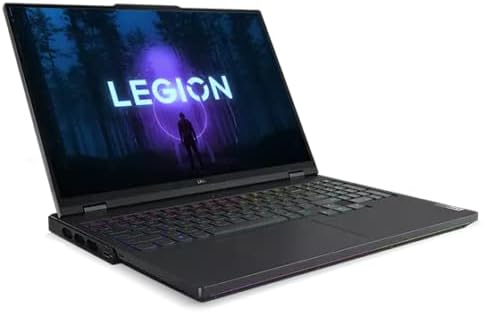
Pros:
- Top-Tier Performance: The combination of a 3.9 GHz Core i9 processor and 32 GB of DDR5 RAM, coupled with the NVIDIA GeForce RTX 4090 GPU with 16 GB VRAM, ensures unrivaled performance for AutoCAD tasks, gaming, and more.
- Superior Graphics: With the NVIDIA GeForce RTX 4090, this laptop delivers exceptional graphics performance, making it perfect for detailed architectural visualizations and intensive 3D modeling in AutoCAD.
- High-Resolution Display: A 15.6-inch screen with a resolution of 2560 x 1600 pixels and a 240Hz refresh rate offers crisp, smooth visuals, enhancing the design and drafting experience.
- Ample Storage: Dual 1TB SSDs provide fast and extensive storage options, ensuring quick access to large AutoCAD files and projects.
- Robust Connectivity: With six USB 3.0 ports along with Bluetooth and 802.11a/b/g/n/ac wireless types, connectivity options are plentiful for all peripherals and external displays.
- Sleek Design: The laptop’s design is both stylish and functional, providing a professional look suitable for any setting, with the added flair of RGB keyboard lighting for personalization.
Cons:
- Battery Life: While improved, the battery life under heavy usage may not meet the all-day needs of some professionals and students, necessitating regular charging.
- Weight: Weighing 6.1 pounds, the laptop’s portability is somewhat compromised, which could be a concern for users who frequently work on the go.
- Price: Starting at a higher price point, this laptop represents a significant investment, though justified by its high-end specifications and performance.
- Fan Noise: Under heavy load, the cooling system, although efficient, can become noticeably loud, which might be distracting in quiet work environments.
2. ASUS ROG Strix G16
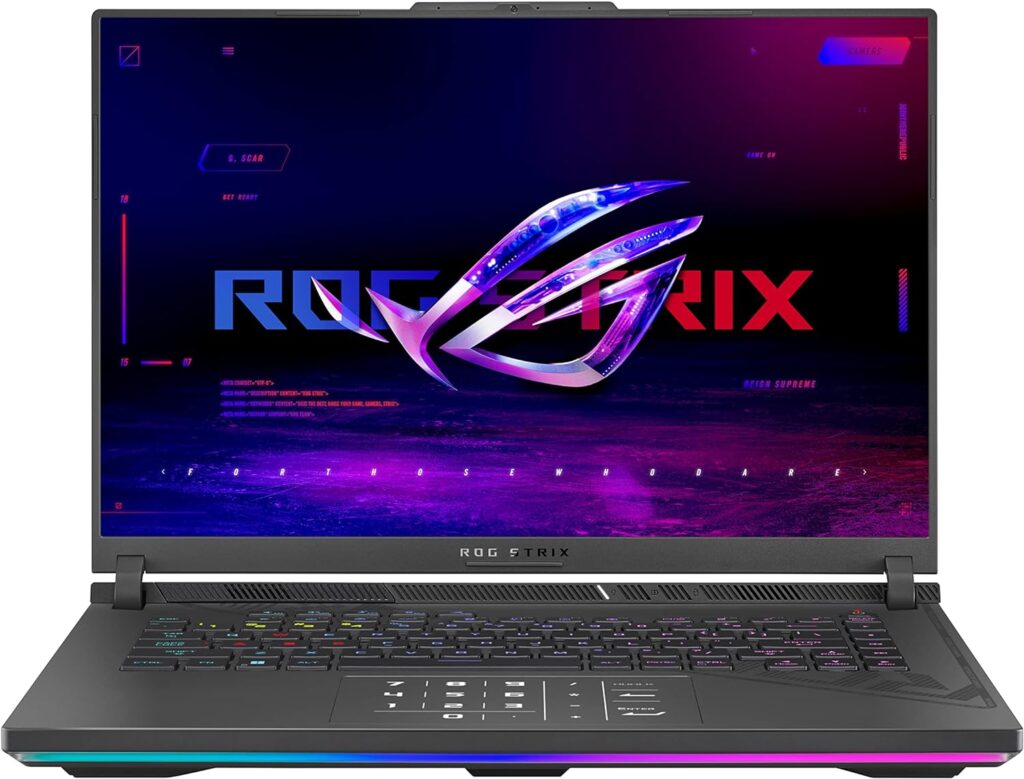
Pros:
- Powerful Performance: With a 5.6 GHz Core i9 processor and NVIDIA GeForce RTX 4070 GPU, the Strix G16 is equipped to handle intense gaming sessions, high-end graphics work, and multitasking with ease.
- Gamer-Centric Aesthetic: The laptop’s design, featuring RGB lighting, transparent keys, and a cyberpunk vibe, appeals directly to gamers looking for style as well as substance.
- High-Quality Display: The 16-inch screen with a QHD+ resolution of 2560 x 1600 pixels and a 240Hz refresh rate offers crisp, vibrant visuals for an immersive gaming experience.
- Excellent Connectivity: With multiple USB ports, Thunderbolt 4, HDMI, and Ethernet, the Strix G16 offers great flexibility for peripherals and external displays.
- Portable Design: Despite its powerful internals, the Strix G16 maintains a relatively portable form factor, making it a good option for gamers on the go.
Cons:
- Moderate Battery Life: The laptop’s battery performance is average, lasting around seven hours on video playback and potentially less during intensive gaming, limiting its utility away from a power source.
- Plastic Components in Chassis: While the laptop is solidly built, the use of plastic in some areas of the chassis may not appeal to those looking for a premium all-metal design.
- Low-Resolution Webcam: The 720p webcam delivers lower quality images than might be desired for streaming or video calls, which could be a drawback for users who prioritize video quality.
- Potential for Heat: The high-powered components in a compact space can lead to heat buildup, especially during prolonged gaming sessions, which might require careful management of cooling and placement.
3. Razer Blade 16
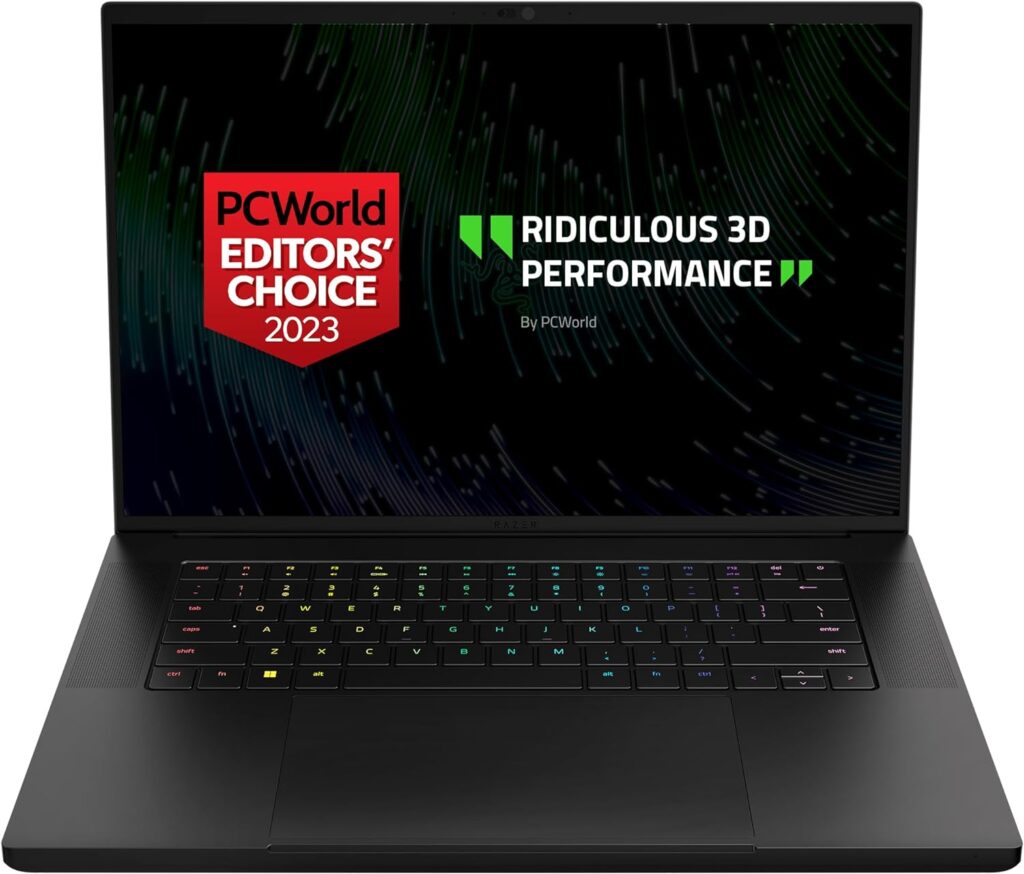
Pros:
- Dual-Mode Display: The Razer Blade 16 features a dynamic-resolution display that toggles between FHD+ at 240Hz for high-speed gaming and UHD+ at 120Hz for detailed productivity work, providing versatility and superior visual quality.
- Robust Performance: Equipped with a 5.5 GHz Intel Core i9 processor and NVIDIA GeForce RTX 4070 GPU, this laptop delivers blistering performance suitable for the most demanding games and creative tasks.
- Sleek Design: The Blade 16 maintains Razer’s premium, all-metal chassis design, offering a sleek and modern aesthetic that’s both durable and stylish.
- Portability: Despite its powerful internals, the Razer Blade 16 is relatively thin and light for a 16-inch gaming notebook, making it easier to carry around than many competitors.
- Advanced Cooling: Featuring vapor chamber cooling to efficiently manage heat, the Blade 16 can sustain high performance without overheating, even in a thinner chassis.
Cons:
- High Price: The Razer Blade 16 is a significant investment, especially considering the starting price includes a relatively mild RTX 4060 GPU.
- Brief Battery Life: The advanced technology and high-performance components contribute to disappointing battery life, limiting the laptop’s usability away from a power source.
- Divisive Logo Design: The neon green Razer logo may not appeal to everyone, especially those looking for a more understated look.
- Limited Value Compared to Rivals: While the Blade 16 offers top-notch design and performance, competitors like the Lenovo Legion Pro 7i Gen 8 and the Alienware m16 deliver more power for less money, making them potentially better values for budget-conscious gamers.
4. MSI Raider GE68HX
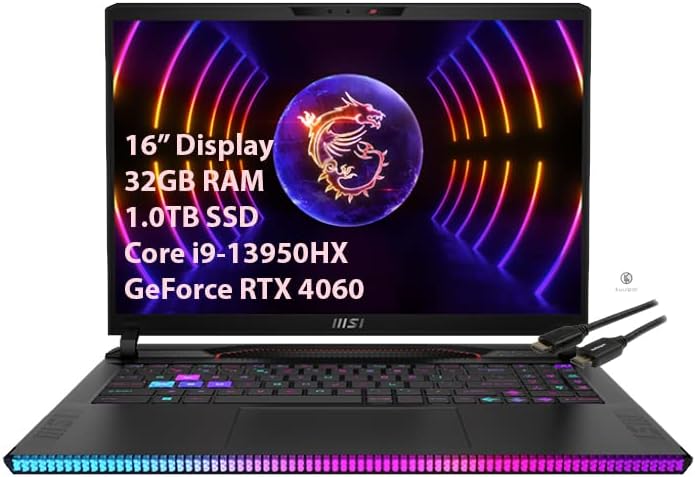
Pros:
- Powerful Performance: Equipped with a 4 GHz Core i9 processor and an NVIDIA GeForce RTX 4060 GPU, this laptop delivers robust performance for gaming and intensive multitasking, positioning it strongly within its category.
- Sturdy Build Quality: The Raider GE68HX features a premium build, with an all-metal chassis that ensures durability without compromising on the device’s aesthetic appeal.
- Extensive Connectivity Options: Offering a variety of ports, including USB 3.2 Gen 2, Thunderbolt 4, HDMI 2.1, and Ethernet, this laptop provides excellent connectivity for all gaming peripherals and external displays.
- Rich Audio Output: With a combination of top-firing and side-firing speakers, the Raider GE68HX offers an immersive audio experience, enhancing the enjoyment of games, movies, and music for those long nights studying.
- Impressive Battery Life: For a gaming laptop, it offers commendable battery life, outlasting many competitors in its class during video playback and light usage scenarios.
Cons:
- Display Limitations: Some configurations of the Raider GE68HX may come with displays that offer limited color gamut and brightness, potentially diminishing the visual experience for gaming and multimedia consumption.
- Weight and Bulk: Despite efforts to streamline its design, the laptop remains relatively heavy and thick, which might deter users looking for more portability in a gaming laptop.
- Cramped Keyboard Layout: The inclusion of a num-pad compromises the layout of the main keyboard area, resulting in smaller arrow keys and a reduced right shift key, which could affect typing and gaming comfort for some users.
- SSD Performance Could Be Better: The built-in SSD doesn’t fully leverage the available PCIe 4.0 x4 bandwidth, leading to suboptimal data transfer speeds that might not meet the expectations of power users.
- Design Prone to Debris Accumulation: The distinctive hinge design and chassis construction may inadvertently trap debris, which could be a minor annoyance and a potential risk over time.
5. Alienware X16 R1

Pros:
- Exceptional Performance: With a 5.4 GHz Core i9 processor and 32 GB of LPDDR5 RAM, this laptop is more than capable of handling AutoCAD’s most demanding tasks, including 3D modeling and complex simulations.
- Superior Graphics: The NVIDIA GeForce RTX 4080 with 12 GB of dedicated VRAM ensures smooth rendering and excellent visual fidelity, crucial for detailed architectural drawings and visualizations.
- High-Quality Display: The 16-inch display with a resolution of 2560 x 1600 pixels, complemented by a high refresh rate of 240Hz, offers crisp and vibrant visuals, enhancing the drafting experience.
- Robust Build Quality: Constructed from anodized aluminum and magnesium alloy, the laptop’s chassis is designed for durability, making it a reliable choice for professionals on the move.
- Advanced Cooling System: Equipped with four cooling fans, multiple copper heat pipes, and a vapor chamber, the X16 R1 manages heat efficiently, maintaining performance during intensive use.
- Customizable RGB Lighting: The AlienFX touchpad and per-key RGB-lit keyboard not only add aesthetic appeal but also allow for a personalized user experience.
Cons:
- Pricey: With configurations ranging up to $4,000, the Alienware X16 R1 is a significant investment, potentially putting it out of reach for students or professionals with tighter budgets.
- Port Placement: The placement of ports at the back of the system can be inconvenient for users who frequently plug and unplug devices, requiring a bit of extra effort to access.
- Fan Noise: The advanced cooling system, while effective, can produce noticeable noise under heavy load, which might be distracting in quiet work environments.
- Battery Life: Like many high-performance laptops, the X16 R1’s battery life may struggle to last through a full day of intensive use, necessitating regular access to a power source.
- Weight: Weighing in at 6 pounds, this laptop is on the heavier side, which could impact its portability for professionals or students who travel frequently.
6. ASUS Zenbook Pro 14
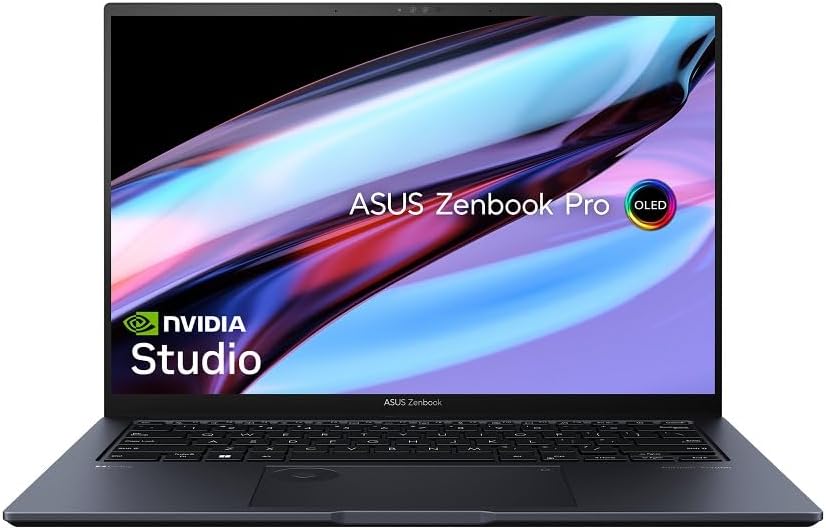
Pros:
- Impressive Performance in a Compact Size: Equipped with an Intel Core i7-13700H processor and an RTX 4060 GPU, this laptop offers considerable power for demanding applications like Adobe Premiere Pro, Blender, and AutoCAD, all within a compact frame.
- High-Quality OLED Display: The 14.5-inch glossy OLED display, with a resolution of 2880×1800 pixels and a refresh rate of 120 Hz, provides stunning visuals, perfect contrast, and vibrant colors, making it ideal for detailed design work.
- Solid Build and Design: The chassis, made from solid matte aluminum with ample cooling grids, combines durability with a sleek, professional appearance.
- Innovative Asus Dial Feature: A unique addition that offers intuitive control over volume, brightness, and specific features in Microsoft Office and Adobe Creative Cloud, enhancing productivity.
- High-Speed Storage: A 1TB SSD ensures fast boot times and quick access to files and applications, complemented by impressive disk read/write speeds.
Cons:
- Limited RAM for Multitasking: With 16GB of RAM, users might find multitasking with high-demand applications slightly constrained, particularly when working with complex 3D models or multiple layers of 4K video.
- Moderate Battery Life: The battery lasts about two hours under high load and full brightness, requiring frequent access to a power source for intensive tasks, which might limit mobility for some users.
- Heat Management: While the laptop manages heat to some extent, its compact size means it can get hot quickly under load, particularly on the underside, making it less suitable for use on a lap.
- Weight and Portability: Weighing 3.63 pounds and measuring almost two centimeters at its thickest, it’s compact but not the lightest or thinnest, which could affect its portability.
- App Confusion: The presence of multiple Asus applications for system and screen settings could lead to confusion, suggesting a need for streamlining.
Selecting the Ideal Laptop for Architectural Excellence
In the quest for the best laptop for architects, the right blend of power, precision, and portability becomes paramount. Architects require machines that can seamlessly run demanding software like AutoCAD, Revit, and 3D modeling programs, while also offering the durability and display quality needed for design and presentation work. Each laptop reviewed here brings its own strengths to the table, catering to different facets of architectural work, from intensive computing tasks to high-resolution rendering and visual design.
The Lenovo Legion Pro 7i Gen 8 emerges as a top contender, balancing robust performance with value, making it an excellent choice for architects in need of a reliable machine that delivers on multiple fronts. For those who prioritize screen quality for their design and visualization tasks, the Razer Blade 16 with its dual-mode display technology offers unmatched versatility. Meanwhile, the Asus Zenbook 14 Pro OLED stands out for creative professionals, offering vibrant colors and deep contrast that can bring architectural visualizations to life.
Selecting the best laptop for architects involves weighing factors such as processing power, graphics capabilities, screen resolution, and color accuracy, alongside considerations of portability and battery life. Whether it’s for creating detailed architectural plans, 3D modeling, or presenting projects to clients, the right laptop can significantly enhance productivity and creativity. As technology continues to evolve, keeping abreast of the latest advancements in laptop features and performance metrics will ensure architects have the tools they need to excel in their craft.

